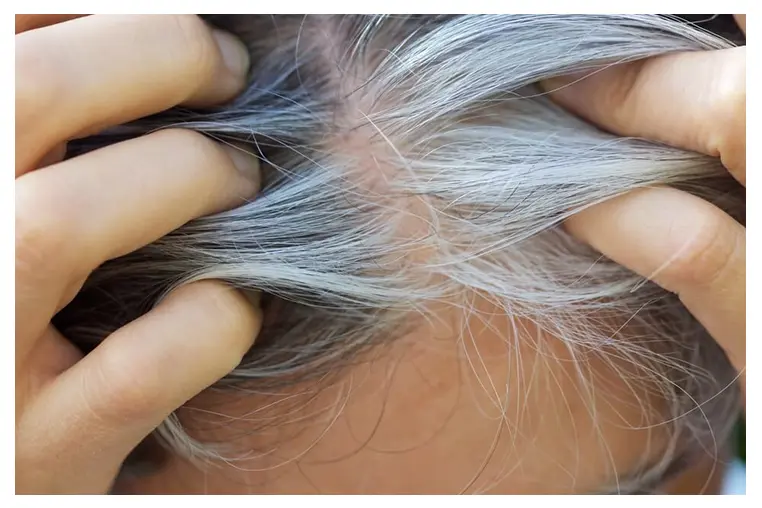
Gray Hair: A Sign of Wisdom or Stress?
06.01.2025
How Do Gray Hairs Form?
To understand why we turn gray, it's helpful to know how hair gets its color: In our hair roots, there are pigment cells that transfer pigments to the hair cells. These pigment granules accumulate in the visible part of our hair, the cortical layers of the hair shaft. These pigment cells are called melanocytes. They are responsible for producing the pigment melanin. There are two types of melanin granules: the black-brown eumelanin and the red-yellow pheomelanin. The ratio of these two substances, as well as the overall amount of pigment stored in each hair, determines the color of our hair.
However, as we age, melanocytes produce less melanin. As a result, the hair stores less pigment, leading to gray hair. Interestingly, the gray color is merely an illusion. Gray hair occurs because pigmented hairs lie next to depigmented ones. Another possible effect is that the hair can store oxygen bubbles. When these bubbles scatter the light, it creates the impression of white hair. In reality, the hair is colorless.
When Do You Get Gray Hair?
The age at which hair turns gray is genetically determined. If parents got gray hair early, there is a high chance that their children will also turn gray earlier. Generally, gray hair appears between the ages of 30 and 50.
In addition to genetic factors, environmental influences such as air pollution, UV radiation, smoking, and an imbalanced diet can promote graying. These factors may lead to the formation of free oxygen radicals (Reactive Oxygen Species, ROS), which can damage the cells responsible for hair color.
Stress and Gray Hair
The theory that stress is linked to gray hair has existed for a while. However, for a long time, there was no scientific proof. Now, some studies confirm these connections and explain the possible mechanisms behind it.
One study that received particular attention was published by the Vagelos College of Physicians and Surgeons at Columbia University in 2021. Although the study only involved 14 participants, its findings are quite fascinating. The researchers developed a novel method to precisely measure hair graying.
They created highly detailed images of tiny human hair slices to quantify pigment loss. Each slice was only one-twentieth of a millimeter thick, equivalent to about one hour of hair growth. The scientists compared the color of the individual hair sections with the participants' stress diaries. The result: during stressful times, hair grew back more gray.

Can Natural Hair Color Return Through Rest?
Stress seems to indeed cause hair to gray. But can natural hair color return through rest and relaxation? One participant in the US study actually experienced some hair regrowth in its original color when they were on vacation.
"The data shows that human aging is not a linear, fixed biological process, but that it can be at least partially halted or even temporarily reversed," explained Martin Picard, behavioral medicine specialist and lead author of the study, in a press release from the university.
However, the expert dampened excessive hopes: "Based on our mathematical modeling, we assume that the hair must reach a certain threshold before it turns gray," said Picard. "In middle age, when the hair, due to biological aging and other factors, approaches this threshold, stress can cause it to exceed and turn gray."
It is therefore unlikely that a 70-year-old who has been gray for years will regain dark hair through relaxation. Or that extreme stress in a 10-year-old would be enough to make their hair gray.
What Can You Do About Gray Hair?
Unfortunately, there is not much you can do about gray hair at the moment (yet). The good news, however, is that gray hair is usually not a medical problem, but rather an aesthetic one. Hair can be dyed using various products. Unfortunately, hair dyes are not always the best for skin and hair. They can sometimes cause allergic reactions, hair loss, or inflammation. (Source: Deutscher Allergie- und Asthmabund e.V.)
Tips for Healthy Hair
Regardless of whether you have gray hair or not, you can ensure that your hair looks healthy, shiny, and strong. Here are some tips for you:
1. Healthy Diet: Make sure to have a balanced diet. Nuts, fish, and fresh fruit are good for your hair.
2. Drink Water: Hydration is key for healthy hair. Drink plenty of water.
3. Hair Care: Use mild shampoos and conditioners. Harsh products can damage the hair. It’s worth checking the ingredients. Avoid products that contain sulfates, silicones, and parabens.
4. Regular Visits to the Hairdresser: A visit to the hairdresser can help prevent split ends and keep your hair looking fresh.
5. In addition to the right care, getting enough sleep is important for healthy hair. This is because the sleep hormone melatonin (not to be confused with melanin, which gives hair its color) can stimulate hair growth.

Conclusion
Gray hair is inevitable, but usually not a cause for concern. However, if you find that stress is the trigger, measures to reduce stress may help you.
